Gráfico de iridologia de Bernard Jensen - A iridologia, o estudo dos padrões da íris e sua correlação com as condições de saúde, é praticada há séculos. Entre os pioneiros nesta área, o Dr. Bernard Jensen destaca-se pelas suas significativas contribuições para a iridologia moderna. Seus gráficos detalhados da íris tornaram-se ferramentas fundamentais para profissionais de todo o mundo que os utilizam para avaliar condições de saúde por meio do exame da íris. Este guia abrangente explora a abordagem revolucionária de Jensen à iridologia, detalhando a estrutura do seu gráfico e explicando como interpretar as marcações da íris de acordo com a sua metodologia.

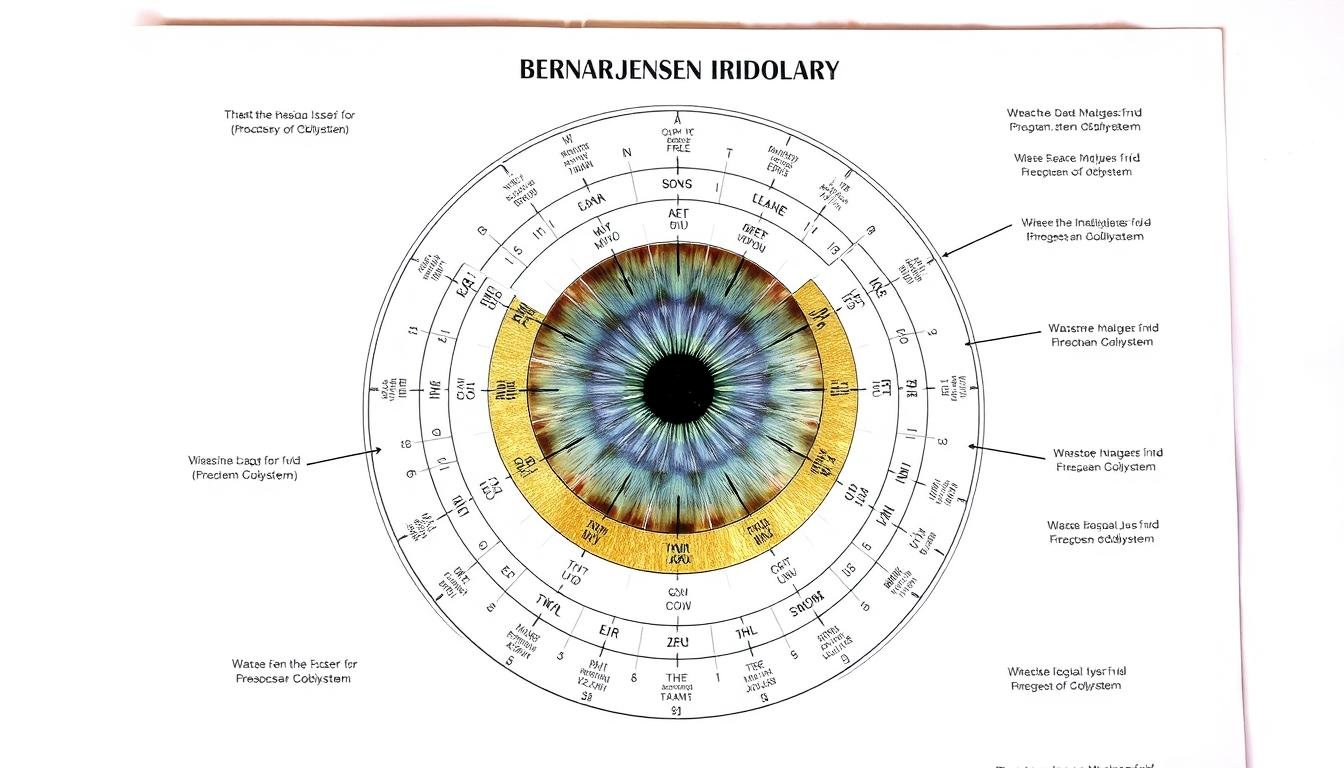
O Legado do Dr. Bernard Jensen em Iridologia
Bernard Jensen (1908-2001) foi um quiroprático americano que dedicou mais de 50 anos à pesquisa e desenvolvimento da iridologia como ferramenta de diagnóstico. Na década de 1950, Jensen começou a ensinar seus métodos nos Estados Unidos, aumentando significativamente a popularidade e a credibilidade da área nos círculos da medicina alternativa.
A abordagem de Jensen foi única porque combinou conceitos tradicionais de iridologia europeia com as suas observações clínicas de milhares de pacientes. Seu trabalho culminou na criação de gráficos detalhados da íris que mapeavam áreas específicas da íris para órgãos e sistemas corporais correspondentes.
Ao contrário dos profissionais anteriores, Jensen enfatizou a importância da exposição a toxinas na avaliação da saúde e defendeu os alimentos naturais como desintoxicantes. Sua abordagem holística conectou a análise da íris com a nutrição, tornando sua metodologia particularmente atraente para aqueles interessados em práticas naturais de saúde.
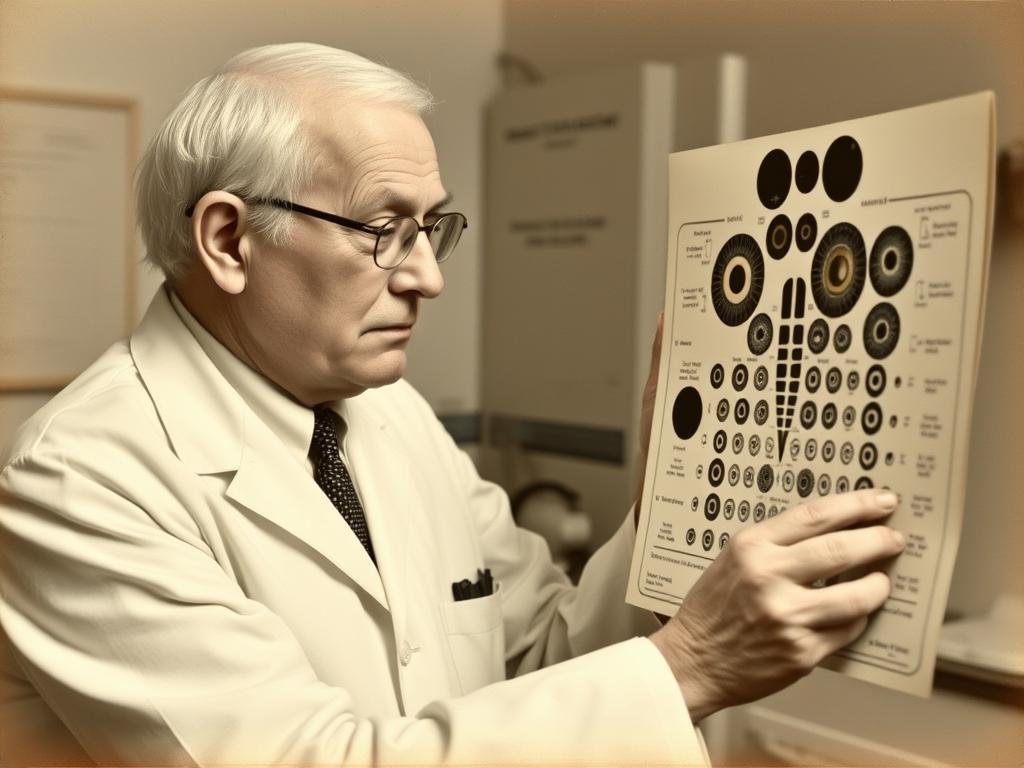
Jensen é autor de vários livros sobre iridologia, incluindo “A ciência e a prática da iridologia” e “Iridologia Simplificada,” que continuam sendo textos influentes na área hoje. Sua dedicação em documentar alterações no tecido da íris e correlacioná-las com condições de saúde criou uma abordagem sistemática que os profissionais ainda seguem.
Estrutura e Zonas do Gráfico Iridológico de Bernard Jensen
O Gráfico de iridologia de Bernard Jensen divide a íris em aproximadamente 80-90 zonas através de um sistema de mapeamento de 360 graus. Cada zona corresponde a órgãos, glândulas ou sistemas corporais específicos. Compreender esta estrutura é essencial para uma interpretação precisa da íris.
O sistema de mapeamento de 360 graus
O gráfico de Jensen usa uma abordagem de relógio para mapear a íris. O gráfico está orientado com o nariz na posição 3 horas para o olho direito e 9 horas para o olho esquerdo. Esta orientação cria um mapeamento espelhado entre os dois olhos.
O gráfico divide a íris em anéis concêntricos que irradiam da pupila até a borda externa. Esses anéis representam diferentes sistemas corporais, com áreas mais próximas da pupila geralmente correspondendo aos órgãos digestivos e aquelas próximas à borda externa relacionadas à pele, vasos linfáticos e extremidades.

Zonas Principais e Suas Correlações
O gráfico de Jensen identifica várias zonas críticas nas quais os profissionais se concentram durante a análise:
- O sistema digestivo forma um anel interno ao redor da pupila
- O sistema linfático aparece na zona média da íris
- A pele, representando o limite de eliminação, forma o anel externo
- O sistema nervoso irradia do centro como os raios de uma roda
- Órgãos específicos têm posições designadas (por exemplo, coração às 2-3 horas no olho esquerdo)
Gráfico de iridologia Bernard Jensen - O gráfico de Jensen é único em sua subdivisão detalhada dessas zonas principais em regiões mais específicas, permitindo a identificação precisa de possíveis problemas de saúde.

Gráfico de iridologia e olho direito -Iridologia -olho direito
OLHO DIREITO reflete lado direito corpo.
| Posição do relógio (olho direito) |
Corresponde Organ/System |
Detalhes |
| 1 hora - 2 horas |
Rosto direito |
Corresponde aos órgãos reprodutivos esquerdos, incluem útero, ovários (mulheres) ou testículos (masculino). |
| 2 horas - 3 horas |
Garganta direita
|
Os elevadores de saúde deixaram as juntas, incluem joelhos, quadris, cotovelos e ombros. |
| 3 horas - 4 horas |
Parte superior da parte superior da parte de trás
|
Corresponde à coluna vertebral, saúde da coluna vertebral, alinhamento e flexibilidade. |
| 4 horas - 5 horas |
Bexiga direita |
Anel Flacks bexiga e sistema urinário do lado direito. |
| 5 horas - 6 horas |
Pélvico direito |
RingPresents deixaram o cólon, o intestino delgado e a saúde digestiva. |
| 6 horas - 7 horas |
Abdômen inferior direito
|
Os elegantes do rim esquerdo, foco na filtração, desintoxicação e balanço de fluidos. |
| 7 horas - 8 horas |
Abdômen superior direito
|
Os elegantes do estômago e os órgãos digestivos no lado esquerdo. |
| 8 horas - 9 horas |
Tórax direito |
Corresponde ao fígado do lado esquerdo, desintoxicação responsável e produção biliar. |
| 9 horas - 10 horas |
Pulmão direito |
RingPresents Lado esquerdo Coração, saúde cardiovascular e circulação afetada. |
| 10 horas - 11 horas |
Pescoço direito |
Os elegantes deixaram o pulmão, a saúde respiratória e a função BRA. |
| 11 horas - 12 horas |
Cérebro direito
|
Corresponde ao cérebro do hemisfério esquerdo, à saúde mental e às funções cognitivas. |
| 12 horas - 1 hora |
Cérebro direito
|
Corresponde ao cérebro do hemisfério esquerdo, à saúde mental e às funções cognitivas. |

Gráfico de iridologia para o olho esquerdo - gráfico de iridologia - olho esquerdo
olho esquerdo reflete lado esquerdo corpo.
| Posição do relógio (olho esquerdo) |
Corresponde Organ/System |
Detalhes |
| 1 hora - 2 horas |
Pescoço esquerdo
|
Corresponde a órgãos reprodutivos corretos, incluem útero, ovários (mulheres) ou testículos (masculinos). |
| 2 horas - 3 horas |
Pulmão esquerdo |
As articulações à direita de saúde dos elevadores de saúde incluem joelhos, quadris, cotovelos e ombros. |
| 3 horas - 4 horas |
Tórax esquerdo |
Corresponde à coluna vertebral, saúde da coluna vertebral, alinhamento e flexibilidade no lado direito. |
| 4 horas - 5 horas |
Abdômen superior esquerdo
|
Anel Flacks bexiga e sistema urinário do lado esquerdo. |
| 5 horas - 6 horas |
Abdômen inferior esquerdo
|
RingPresents Direito Cólon, intestino delgado e saúde digestiva. |
| 6 horas - 7 horas |
Esquerdo pélvico
|
Os elegantes do rim direito, foco na filtração, desintoxicação e equilíbrio de fluidos. |
| 7 horas - 8 horas |
Esquerda na região lombar
|
Os flutuadores do estômago e os órgãos digestivos no lado direito. |
| 8 horas - 9 horas |
Esquerda na parte superior das costas
|
Corresponde ao fígado do lado direito, desintoxicação responsável e produção biliar. |
| 9 horas - 10 horas |
Garganta esquerda
|
RingPresents Heart Lado direito, saúde cardiovascular e circulação afetada. |
| 10 horas - 11 horas |
Rosto esquerdo |
Os elegantes do pulmão direito, a saúde respiratória e a função BRA. |
| 11 horas - 12 horas |
Cerebro esquerdo |
Corresponde ao cérebro do hemisfério direito, à saúde mental e às funções cognitivas. |
| 12 horas - 1 hora |
Cerebro esquerdo |
Corresponde ao cérebro do hemisfério direito, à saúde mental e às funções cognitivas. |
- OLHO DIREITO: Toques Lado direito corpo (por exemplo, Certo rim, Certo pulmão, Certo órgãos reprodutivos, etc.).
- Olho esquerdo: Toques Lado esquerdo corpo (por exemplo, Esquerda rim, Esquerda pulmão, Esquerda órgãos reprodutivos, etc.).
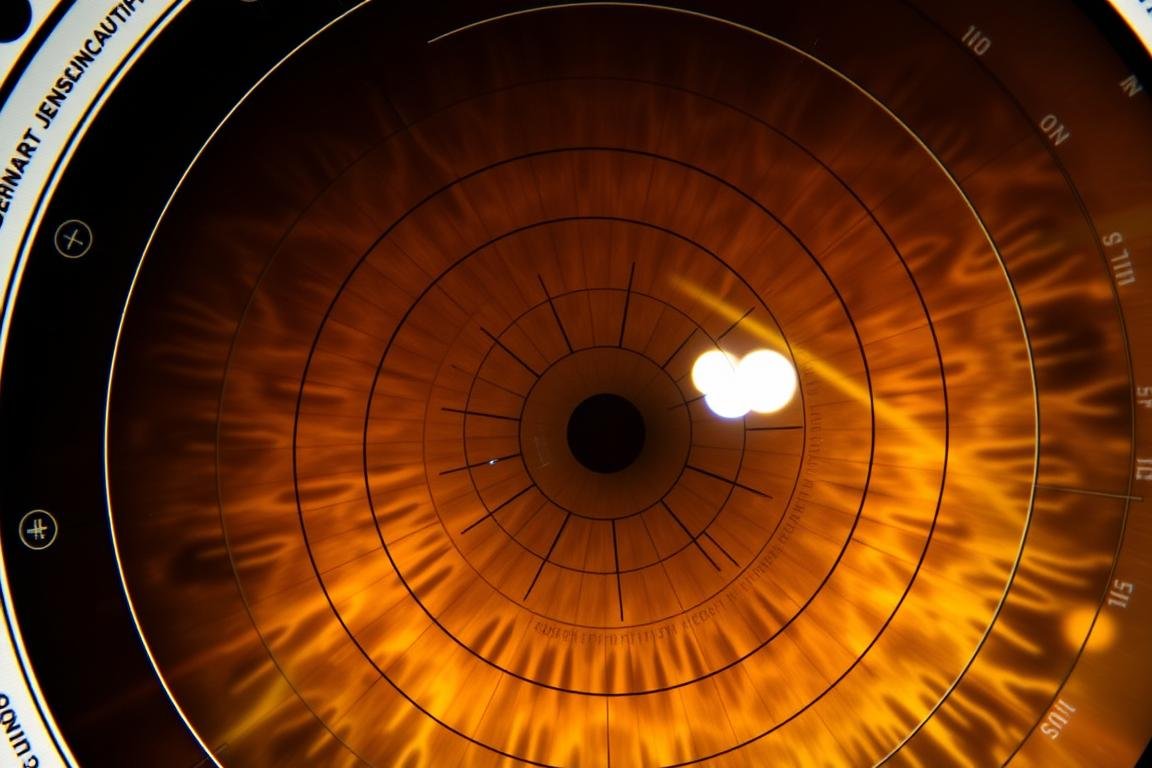
Obtenha seu guia básico gratuito da zona de iridologia
Baixe nossa versão simplificada das zonas iridológicas de Bernard Jensen para começar a aprender como identificar áreas-chave na íris.
Baixe o guia grátis
Interpretando Marcações da Íris de acordo com o Sistema de Jensen
A metodologia de Bernard Jensen para interpretar as marcações da íris baseia-se na premissa de que a íris revela condições agudas e crónicas através de sinais específicos. Compreender essas marcações é crucial para uma avaliação iridológica precisa.
Lesões e lacunas
Eles aparecem como manchas escuras ou aberturas na estrutura das fibras da íris. Segundo Jensen, eles indicam danos nos tecidos ou fraquezas inerentes aos órgãos correspondentes. A profundidade e a escuridão das lesões sugerem a gravidade da doença.
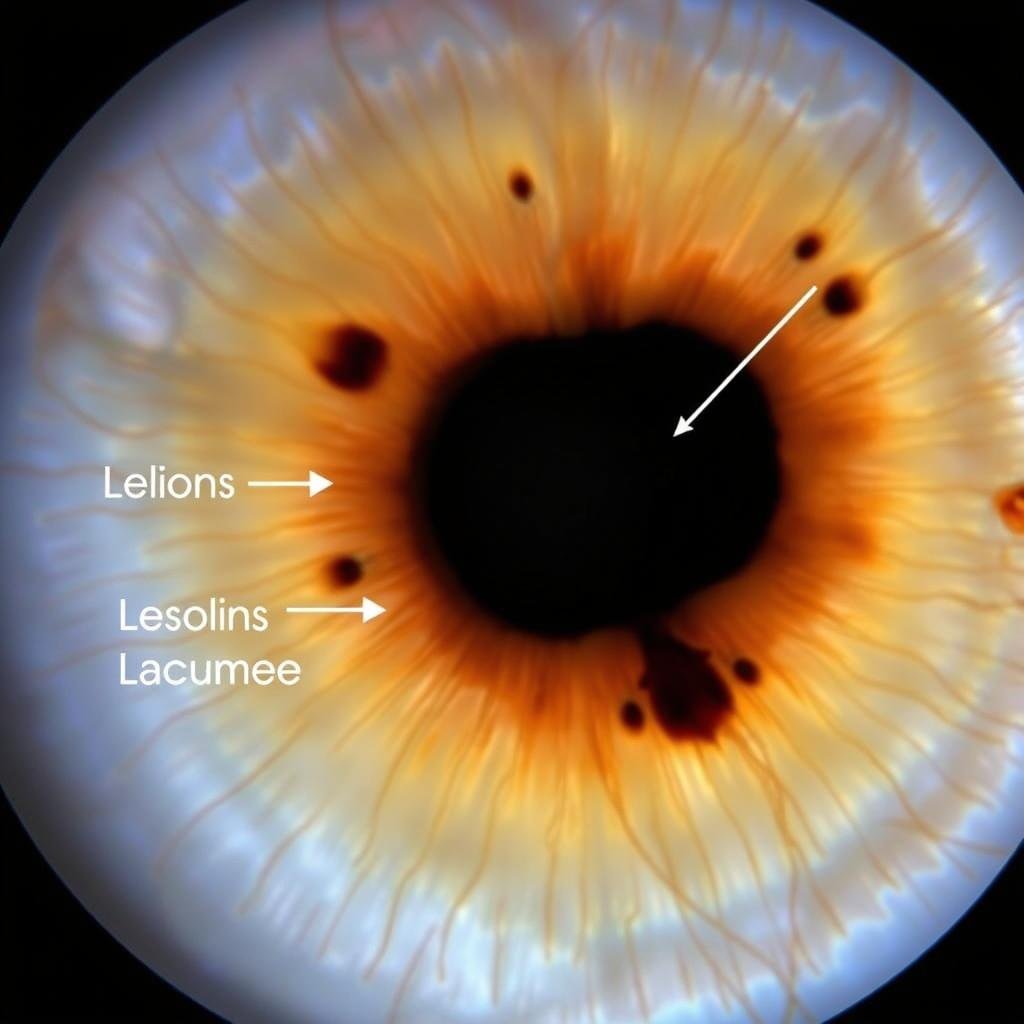
Anéis e Zonas
Os anéis de contração aparecem como arcos circulares ou círculos completos na íris. Jensen interpretou isso como sinais de tensão ou estresse no sistema nervoso. A localização destes anéis indica quais sistemas do corpo são afetados por esta tensão.
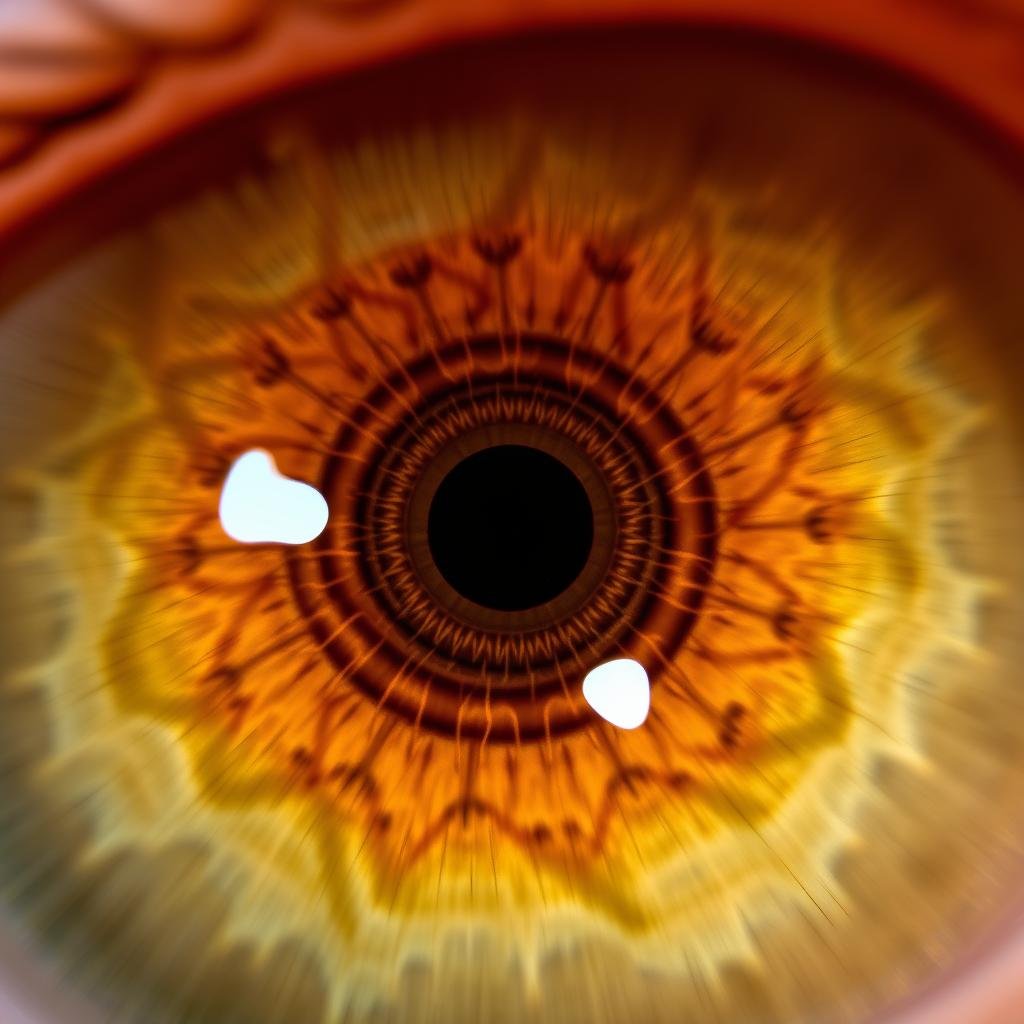
Pigmentação e Cores
O sistema de Jensen dá importância significativa à coloração da íris. As áreas amarelas podem indicar problemas renais ou urinários, enquanto as manchas marrons podem sugerir envolvimento do fígado ou do baço. Branco indica inflamação ou atividade aguda no órgão correspondente.
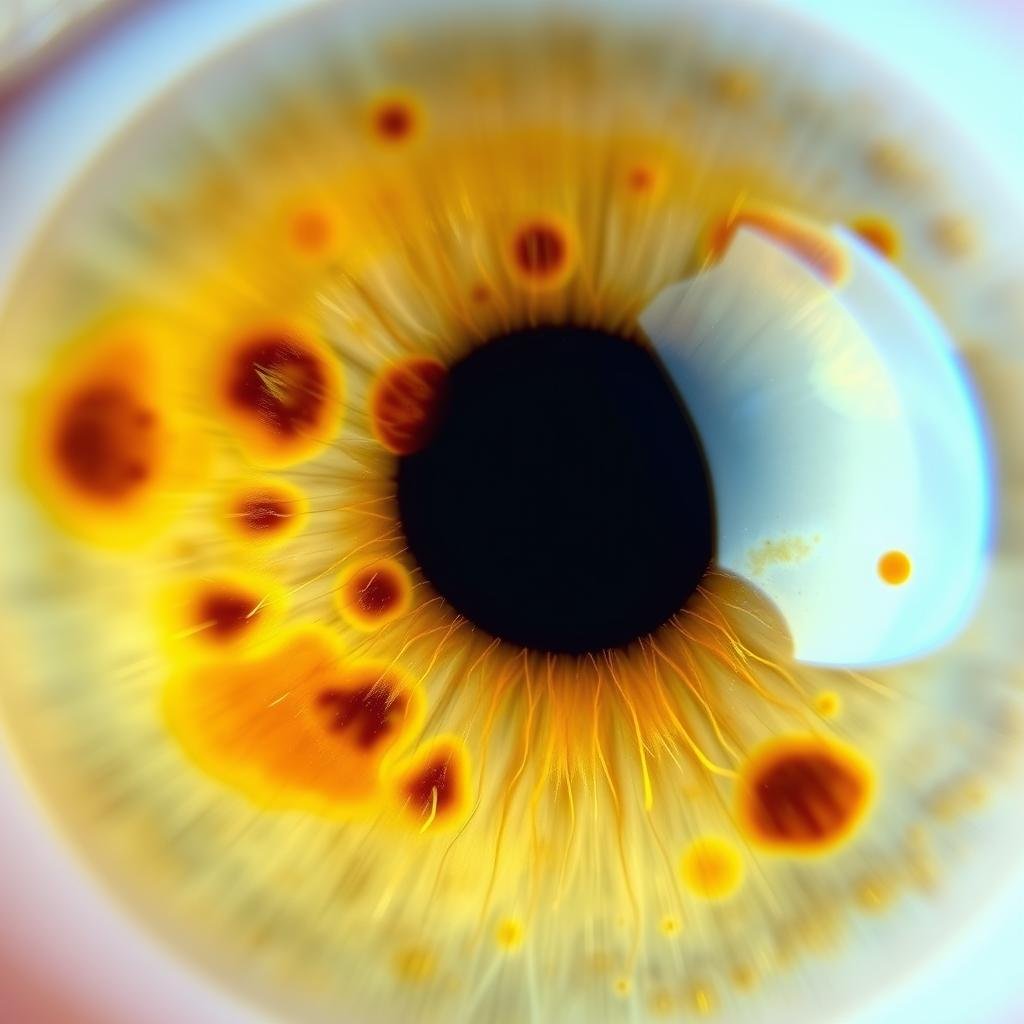
Os quatro níveis de mudança tecidual
Jensen identificou quatro níveis progressivos de alterações teciduais visíveis na íris:
| Nível |
Sinal de íris |
Interpretação |
| Agudo |
Fibras brancas, sinais de inflamação |
Inflamação ativa, condição de luta corporal |
| Subagudo |
Áreas cinza-brancas |
Inflamação crônica, menos ativa |
| Crônico |
Marcas mais escuras, lesões |
Danos ou fraqueza tecidual a longo prazo |
| Degenerativo |
Lesões pretas, lacunas fechadas |
Destruição de tecidos, falência de órgãos |
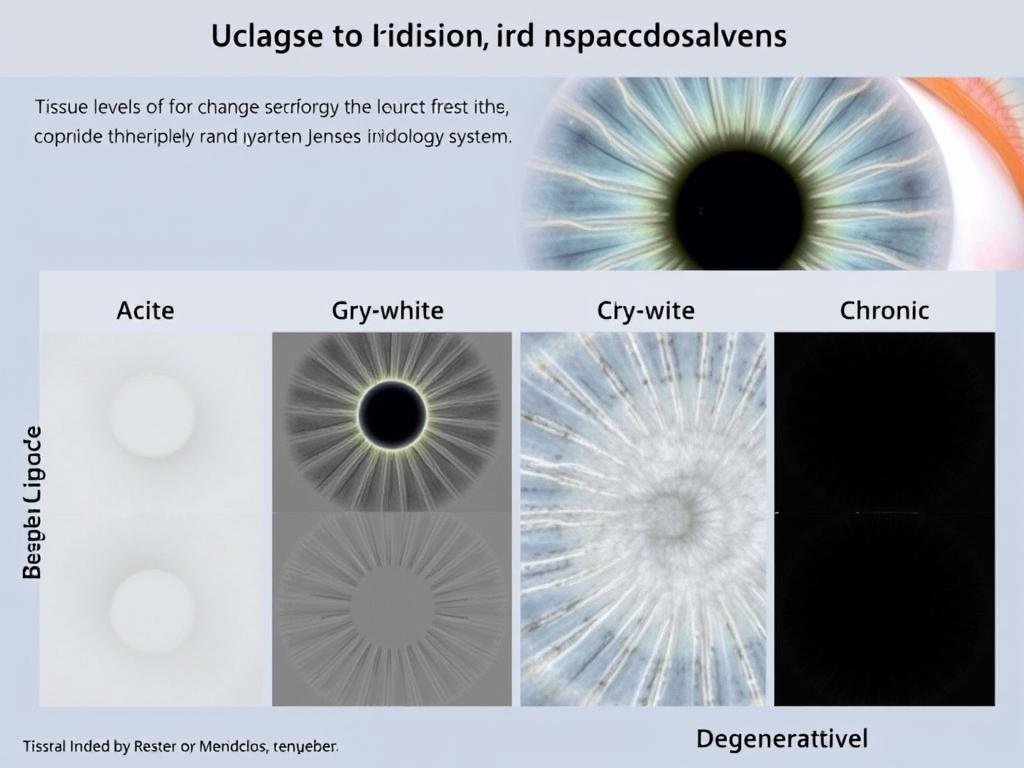
“As fibras nervosas da íris respondem às alterações nos tecidos do corpo, manifestando uma fisiologia reflexa que corresponde a alterações e localizações específicas dos tecidos.”
– Dr. Bernard Jensen
Aplicações Práticas na Prática Holística de Saúde
O gráfico iridológico do Jensen serve como uma ferramenta prática para profissionais de saúde holísticos avaliarem a saúde geral e identificarem potenciais áreas de preocupação. Embora não se destine a diagnosticar doenças específicas, fornece informações sobre os pontos fortes e fracos constitucionais.
Estudo de Caso: Avaliação Nutricional
Os profissionais costumam usar o gráfico de Jensen para identificar necessidades nutricionais. Por exemplo, manchas brancas na zona do pâncreas (por volta das 7 horas no olho direito) podem sugerir inflamação que poderia beneficiar de alimentos e suplementos anti-inflamatórios. Esta abordagem está alinhada com a ênfase de Jensen na nutrição como pedra angular da saúde.
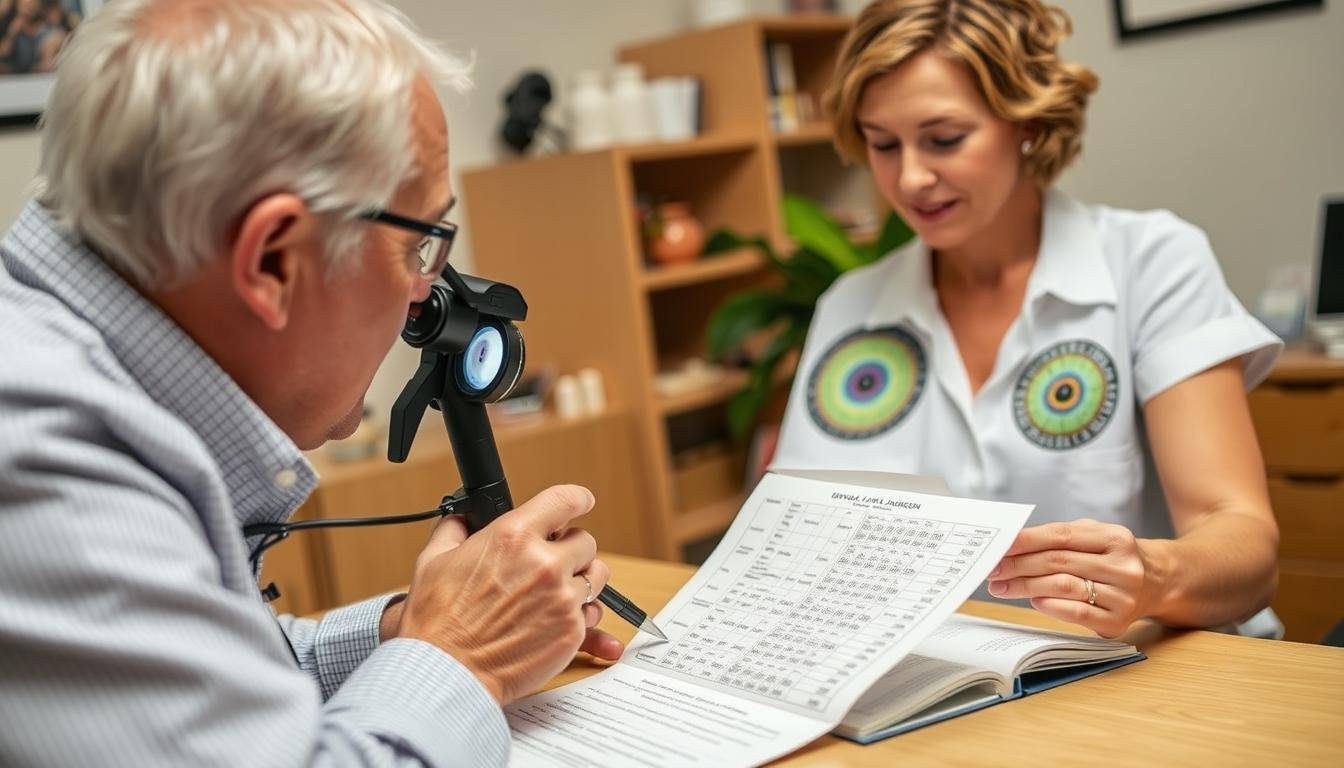
Integração com outras práticas holísticas
Os profissionais holísticos modernos muitas vezes combinam a iridologia de Jensen com outros métodos de avaliação:
- Aconselhamento nutricional baseado em indicações de deficiências minerais na íris
- Recomendações fitoterápicas visando sistemas identificados como fracos na íris
- Protocolos de desintoxicação para órgãos que apresentam padrões de estresse
- Técnicas de gerenciamento de estresse para áreas que apresentam tensão nervosa
Guia abrangente de interpretação de iridologia
Amplie sua compreensão com nosso guia detalhado para interpretar marcações de íris usando a metodologia de Bernard Jensen.
Obtenha seu guia completo
Adaptações Modernas da Metodologia Jensen
Os iridologistas contemporâneos basearam-se nos fundamentos de Jensen, incorporando avanços tecnológicos e novas pesquisas:
Iridologia Digital
Os profissionais modernos costumam usar câmeras digitais de alta resolução e software especializado para capturar e analisar imagens da íris. Esta tecnologia permite uma documentação e comparação mais precisa ao longo do tempo, melhorando a aplicação prática do sistema gráfico do Jensen.
Avaliação Integrada
Os profissionais holísticos de hoje normalmente usam a iridologia como um componente de uma avaliação de saúde mais ampla, e não como uma ferramenta de diagnóstico independente. Esta abordagem integrada alinha-se com a filosofia holística do Jensen, ao mesmo tempo que reconhece as limitações de qualquer método de avaliação único.
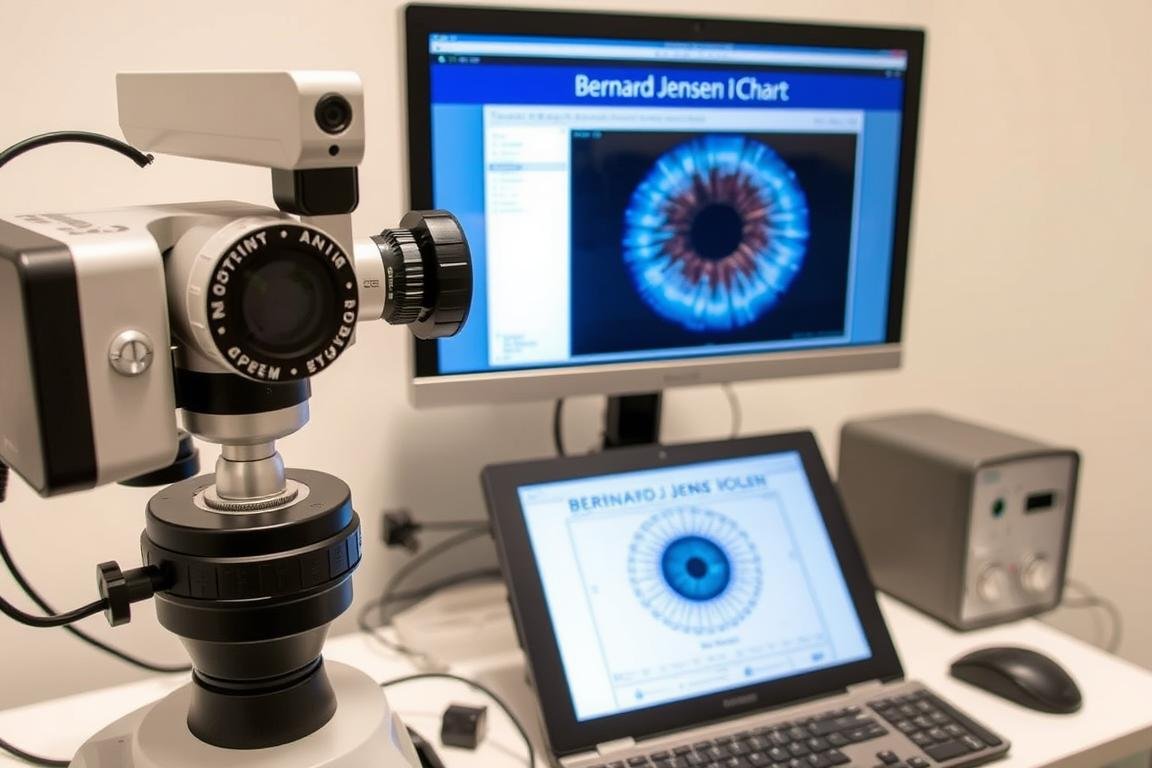
Perspectivas Científicas e Análise Crítica
Embora o gráfico iridológico de Bernard Jensen continue popular nos círculos da medicina alternativa, é importante abordar a perspectiva da comunidade científica sobre esta prática. Compreender tanto as evidências de apoio quanto as críticas fornece uma visão equilibrada.
Argumentos de apoio
- A íris contém milhares de terminações nervosas conectadas ao cérebro
- Sucesso anedótico relatado por muitos profissionais
- Método de Avaliação Não Invasiva
- Potencial sistema de alerta precoce para condições em desenvolvimento
- Incentiva abordagens preventivas de saúde
Críticas científicas
- Falta de estudos controlados que apoiem a precisão do diagnóstico
- A estrutura da íris permanece praticamente estável ao longo da vida
- Testes cegos falhados (por exemplo, estudo de 1979 com o próprio Jensen)
- Nenhum mecanismo fisiológico estabelecido para a conexão órgão-íris
- Risco de atraso no diagnóstico médico adequado
Um notável estudo de 1979 envolveu o próprio Bernard Jensen e dois outros iridologistas examinando fotografias de 143 pacientes.’ íris para identificar doenças renais. Os médicos não conseguiram distinguir com precisão entre pacientes com doença renal e aqueles com função renal normal, levantando questões significativas sobre a fiabilidade diagnóstica do método.

Nota importante: Embora a iridologia possa ser uma ferramenta interessante de avaliação complementar, ela não deve substituir o diagnóstico médico convencional. Sempre consulte profissionais de saúde qualificados para questões médicas.
Conclusão: O Papel do Quadro Iridológico de Jensen na Medicina Complementar
O gráfico iridológico de Bernard Jensen representa uma contribuição significativa para o campo da avaliação holística da saúde. Embora a validação científica permaneça limitada, muitos profissionais e entusiastas encontram valor na sua abordagem sistemática para compreender potenciais padrões de saúde através da observação da íris.
A abordagem mais equilibrada vê a iridologia de Jensen como uma ferramenta complementar e não como uma substituição diagnóstica. Quando utilizado juntamente com a avaliação médica convencional e outras práticas holísticas, pode contribuir para uma compreensão mais abrangente dos padrões de saúde individuais e das tendências constitucionais.
Quer seja um profissional de saúde holístico que procura expandir as suas ferramentas de avaliação ou simplesmente curioso sobre abordagens alternativas à saúde, compreender a metodologia de Jensen fornece informações valiosas sobre um dos sistemas mais influentes da iridologia moderna.
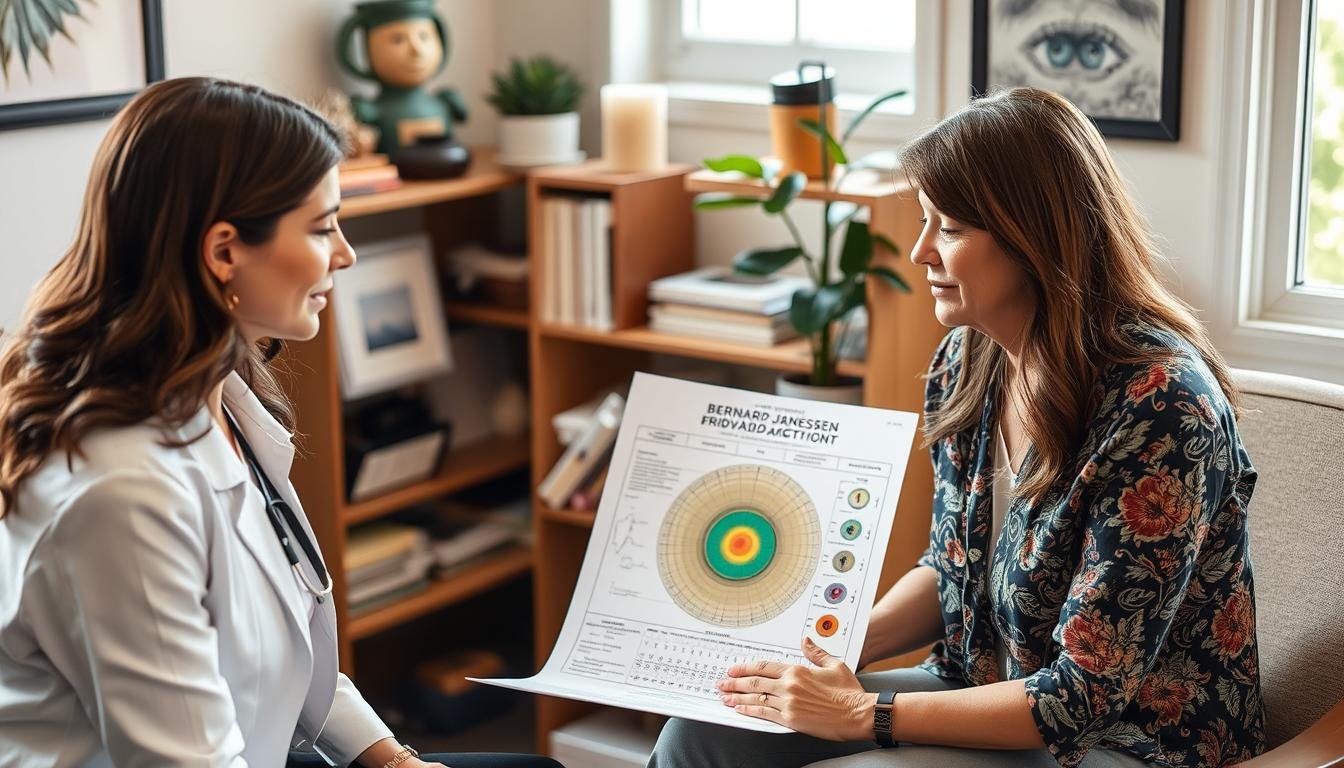
Explore nossa coleção completa de recursos de iridologia
Acesse nossa biblioteca completa de recursos de iridologia, incluindo gráficos para impressão, guias de interpretação e materiais educacionais baseados na metodologia de Bernard Jensen.
Acessar recursos



























